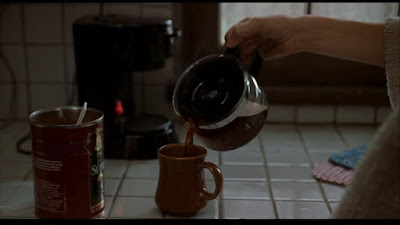In this post, we begin to explore clue number 6 of "David Lynch's 10 clues to unlocking this thriller": Notice the robe, the ashtray, the coffee cup. (Note that we are skipping over clue number 5 - the last clue considered was number 4).


Above left: Diane and the hit man in Winkie's. Notice the brown coffee cup. Above right: Diane at home. Note that the coffee cup is the same kind that's used in Winkie's. This is an indication that Diane, at some point, worked in Winkie's. (This doesn't preclude the possibility that she worked at Pink's, as stated earlier in the analysis. Winkie's would have been a 'step up' for her).


Above left: Diane as 'Betty', wearing a nice pink bathrobe while rehearsing with Rita. Above right: Diane is wearing a worn white robe when her former roommate, L.J. DeRosa, drops by. The idea here is that the scene with the nice robe depicts a dream, while the scenes in which Diane is wearing the white robe depict reality.

Above left: Diane's former roommate retrieves the 'piano' ashtray. Above right: Shortly after this, Diane experiences a masturbatory fantasy in which she and Camilla are together on the couch. However, the fact that the piano ashtray is present indicates that we have reverted to a former moment in time, so this scene actually depicts a 'fantasy-flashback'.
The chain of events involving the former roommate are as follows: When Diane first moved into the Sierra Bonita apartments, she moved into number 12. While living there she befriended a woman named L.J. DeRosa who lived in number 17. At some point Diane moved into number 17 to live with DeRosa, so that both women could save some money on rent. Diane slept on the couch, and DeRosa slept in the bedroom. Then at some point while the two women were living together, Diane made one or more sexual advances toward DeRosa and was rejected, and this created an uncomfortable situation, so it was determined that one of them had to move out. Since Diane had already placed the hit on Camilla, and since she knew her therapist had overheard her doing so while in Winkie's, she knew people would be looking for her, so she convinced DeRosa to move into number 12, and DeRosa did so. When in Diane's dream, Betty and Rita found 'D. Selwyn' in the phone book, she was listed as living at number 12, her old address. (Entries in phone books are generally updated only once per year). It's DeRosa's voice that answers the phone when Betty and Rita call Diane's number. When DeRosa comes back to number 17 to retrieve some items she left there, she awakens Diane, and a brief encounter ensues. When DeRosa says "it's been three weeks", what she means is that it's been three weeks since she moved out of number 17.

Betty and Rita sink down in the back seat of the taxi they're in (above left), to avoid being seen by the two plainclothes detectives sitting in the green car parked near the brick wall (above right), while entering the Sierra Bonita apartment complex. This is Diane's dream representation of herself eluding two detectives who have been looking for her for placing the hit on Camilla.
The two plainclothes police detectives who have been sitting in the car outside Sierra Bonita, initially came calling for Diane at no. 12, and found DeRosa there. DeRosa later told Diane that the police had come looking for her. The detectives then began to 'stake out' the area by waiting on the street near the complex. When they didn't see Diane coming or going, they went to see DeRosa a second time. It was at her visit to Diane to retrieve the rest of her belongings, that DeRosa informed Diane that the two detectives had come looking for her again. She must have told the detectives during one of their visits to her, that Diane was living in apartment 17. The detectives then came by number 17 on that fateful evening that Diane was sitting in her apartment staring at the blue key. When they began to knock on the door, Diane hallucinated, seeing the couple that raised her, then she killed herself.
What all this does not imply, is that Camilla is simply a representation of DeRosa. Camilla is a (real) woman whom Diane placed a hit on, but Diane only fantasized that she had had lesbian encounters with Camilla. The real 'love story' of the movie is the one between Diane and Adam, although as stated earlier, this love is purely one-sided, on Diane's part; i.e., she loves Adam 'from afar'.

Diane (above left) is upset by Adam and Camilla getting close (above right) at the Mulholland Drive party. This is because she is in love with Adam, and is jealous of Camilla.
There is no actual lesbian relationship or lesbian sex being depicted in the movie. The sex between Betty and Rita takes place in a dream, and Diane's sexual encounter with Camilla is a fantasy, as noted above. And, Diane only hoped to have sex with DeRosa.
The event that triggered Diane's lesbian fantasies, was her seeing a blond woman kiss Camilla at the Mulholland Drive party. What we see here is Diane's interpretation of the kiss, whereas in all likelihood it was, in reality, just a peck on the cheek from a friend.



